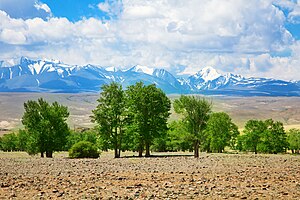- For other places with the same name, see Altai (disambiguation).

Altai (Russian: Респу́блика Алта́й rees-POOB-leek-uh uhl-TIGH) is a republic in Western Siberia, which has an amazing variety of landscapes: from boundless steppes to impassable taiga forests.
The Altai Mountains are the highest in Siberia. The Altai Republic and nearby Altai Krai were very popular hunting, fishing and adventure tourist sites during Soviet times. The region is popular for rafting, kayaking, rock climbing, horse riding, fishing and hunting.
Understand
editThe region borders Kemerovo Oblast to the north, Khakassia to the northeast, Tuva to the east, Mongolia to the southeast, China to the south, Kazakhstan to the southwest, and Altai Krai to the northwest.
The people of this republic are mainly ethnic Altais, a Turkic ethnicity. The following a wide variety of religions including Russian Orthodoxy, Shamanism and Buddhism. Thus, this region is Russia's most religiously diverse.
The modern Altai economy is based largely upon agriculture, but nowadays the tourism industry has undergone an exponential growth. Despite the rapid growth of tourism, the region is one of the poorest and most underdeveloped places in Russia.
Cities
editOther destinations
edit

Altaisky Nature Reserve along with the Katun Nature Reserve and the Ukok Plateau Nature Refuge were listed as one of UNESCO World Heritage Sites under the name "Golden Mountains of Altai"
Talk
editGet in
editGet around
editMarshrutka is the most common way of public travel there. It is a type of taxi, which goes once it gets full. Information about routes can be found at the bus station in Gorno-Altaisk. Locals don't tend to know information about buses and marshrutkas (May 2021) and it may be difficult travel that way along the Chuysky Highway.
Hitchhiking is quite common too. Sometimes you can stop even a child on a horse. Alternatively, you can rent a car in Gorno-Altaisk or Barnaul.
See
edit
- Lake Teletskoye - one of the largest lakes in Russia, after Baikal.
- 77 km away from the capital at the village Kamlak there is the Gorno-Altaisk Botanical Garden, situated on the unique natural corner Shishkular-Katail-Chisty lug (Шишкулар-Катаил-Чистый луг). It is a department of Russian Academy of Science and an interesting place to visit. The collected plants range 1535 species from Altai, Siberia, the Far East and even North America.
- KM723-732 from Novosibirsk: A series of ancient (10,000BC) rock paintings and carvings can be seen on the main road that passes through the Altai Republic.
- Seminsky pass - the highest point on the Chuysky Highway.
Do
editCampsites
editSo far there are three big congregations of private campsites, rest bases and guesthouses, majority of them in the north, where the climate is warmer:
- Northern shores of Teletskoye lake close to Iogach and Artybash villages.
- Complex of campsites along the Katun river, known as 'Biryuzovaya Katun', Бирюзовая Катунь, all accessible from Chuysky Highway, which runs parallel to the river.
- Riverside campsites continue south with tributary Chemal and are mostly concentrated in Chemal village.
To get there tourists buy tours in big cities or call to the owners beforehand and then arrive. One can try their luck and certainly will find a stay on the spot.
Mountain climbing
editFor serious mountaineers and hikers, there are two mountains to consider. Permits must be arranged weeks or months in advance.
- Belukha - get there via Ust-Koksa.
- Aktru - get there via Kurai. Blue Lake is accessible from base camp and doesn't require a permit.
Hiking
edit- Mount Sinyukha near Manzherok
- Mount Sarlyk near the Seminsky pass
- Karakol Lakes near Elekmonar (5 km north of Chemal)
There are plenty of options for day and multi-day hikes all around the region.
Eat
editEat at cafes, which are cheap and quite good. Cafes are common all around Russia, even in small villages.
Drink
editStay safe
edit- Be aware of ticks, mainly in summer.
- The region is prone to earthquakes.
Stay healthy
editTap water is considered unsafe for drinking, and should be avoided. Being one of Russia's poorest regions, only 60% of the area's population has access to safe drinking water. Sanitize all water, and drink only water that is bottled.
Hospitals are well equipped and the staff are well trained, but good quality health care in Altai is virtually non-existent. Most of the hospitals are equipped with neglected technology, and serious operations are seemingly impossible to do here.
Go next
editCross the border into Mongolia and visit Bayan-Ulgii Province, its capital, Ölgii, has a large Kazakh population living much the same way they did 100 years ago. Also visit Altai Tavan Bogd National Park and Tsambagarav National Park to enjoy large snow-capped mountains, petroglyphs, Turkic Stone Men, and Kazakh Eagle Hunters.


